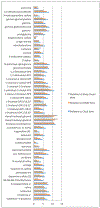Diurnal variation of metabolites in three individual participants
- PMID: 30557062
- PMCID: PMC6448392
- DOI: 10.1080/07420528.2018.1541901
Diurnal variation of metabolites in three individual participants
Abstract
The circadian system influences virtually all biological functions. Understanding the impact of circadian variation on metabolism may provide insight into mechanisms of circadian-associated disorders and guide the implementation of chrono-therapy. Previous research has reported circadian variation in 7-20% of metabolites in human blood. In this study, untargeted metabolomics profiles were measured using blood of two healthy men and one healthy woman, collected every 2 h for up to 48 h under carefully controlled conditions. The pattern of variation of each metabolite over time was examined on each participant separately, using both one- and two-order harmonic models. A total of 100 of 663 metabolites, representing all metabolite categories, showed diurnal rhythmic concentrations that exceeded the Bonferroni threshold (P < 2.5 × 10-5). Overall, peak times of many metabolites were clustered during the afternoon-midnight, including the majority of amino acids, all peptides, all lysolipids and all phospholipids, whereas the majority of steroids peaked in the morning. We observed substantial inter-individual variation for both peak times and amplitudes in these three subjects. In conclusion, at least 15% of blood metabolites, representing a broad group of biological pathways, exhibit diurnal variation in three participants. The average peak times of most of these metabolites are clustered in morning or afternoon-midnight. Further work is needed to validate and extend this work in more individuals.
Keywords: Circadian rhythm; diurnal; metabolites; metabolomics.
Conflict of interest statement
Declaration of Interest Statement
The authors declare no conflicts of interest
Figures










References
-
- Ang JE, Revell V, Mann A, Mantele S, Otway DT, Johnston JD, Thumser AE, Skene DJ, Raynaud F. (2012). Identification of human plasma metabolites exhibiting time-of-day variation using an untargeted liquid chromatography-mass spectrometry metabolomic approach. Chronobiology international. 29:868–881. - PMC - PubMed
-
- Brzezinski A (1997). Melatonin in humans. The New England journal of medicine. 336:186–195. - PubMed
-
- Chua EC, Shui G, Lee IT, Lau P, Tan LC, Yeo SC, Lam BD, Bulchand S, Summers SA, Puvanendran K, Rozen SG, Wenk MR, Gooley JJ. (2013). Extensive diversity in circadian regulation of plasma lipids and evidence for different circadian metabolic phenotypes in humans. Proc Natl Acad Sci U S A. 110:14468–14473. - PMC - PubMed
Publication types
MeSH terms
Substances
Grants and funding
LinkOut - more resources
Full Text Sources
Other Literature Sources
